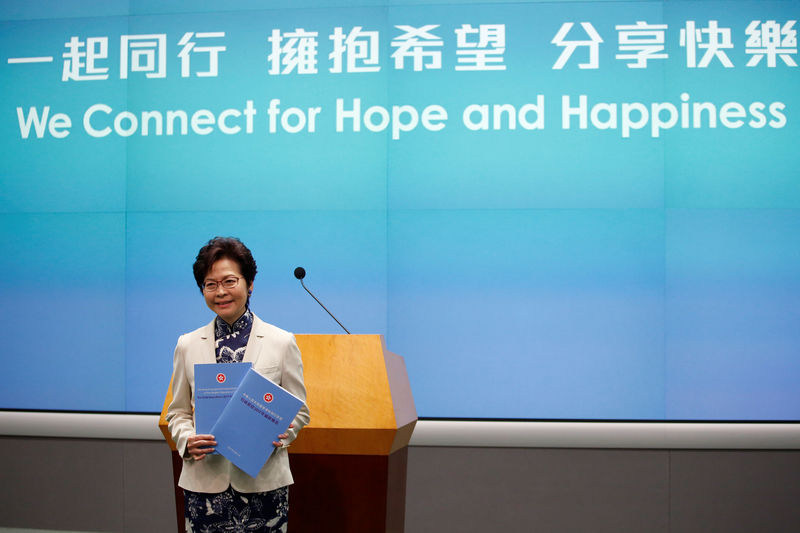 © Reuters. FILE PHOTO – Hong Kong Chief Executive Carrie Lam poses with copies of her policy speech in Hong Kong
© Reuters. FILE PHOTO – Hong Kong Chief Executive Carrie Lam poses with copies of her policy speech in Hong KongBy Marius Zaharia and Anne Marie Roantree
HONG KONG (Reuters) – Hong Kong’s new leader Carrie Lam showed last week that bringing the mojo back to the territory’s once uniquely dynamic economy isn’t going to be easy.
In her first policy address since coming into power in July, the chief executive acknowledged that “Hong Kong is facing increasingly grave challenges,” citing in particular competition from other economies. She called for the development of an economy that was more diversified and fostered leading technologies.
It was an echo of Chinese President Xi Jinping’s comment that Hong Kong’s traditional strengths are “losing their edge, while new drivers of growth have yet to emerge,” during his visit to the city in July.
But economists and investment strategists said that while Lam and her big boss in Beijing may have identified the disease, they have yet to come up with a cure.
In her policy speech she sought to tinker with probably the territory’s biggest social problem – soaring property prices that have put owning an apartment out of reach for many young middle and working class Hong Kongers. And she decided to throw money at another issue – the lack of innovation – by targeting a doubling of the percentage of the city’s gross domestic product that goes to research and development (R&D).
But her “Starter Homes” scheme – meant to provide affordable housing for purchase by lower-income residents – may only make a small dent in the problem. Hopes she would come up with proposals to free up much more land for development weren’t addressed.
Kevin Lai, chief economist for Asia ex-Japan at Daiwa, called the new housing measures and some tax cuts aimed at small businesses “trivial.” He said the government needed to rid young people of the housing burden to allow them to focus on more enterprising activities, which he says would have more success than government-funded projects.
“Unless you give more power to the younger generation your economy will not be able to rebalance,” Lai said. “I’m afraid Hong Kong is losing its relevance to the rest of the world.”
PAST MISSTEPS
There have been a number of faltering attempts by the Hong Kong authorities to diversify the territory’s economy in the past 20 years.
The Cyberport business park, which was first announced in 1999 and built in the following decade, was supposed to make Hong Kong a great incubator for technology start-ups. But many new businesses prefer Shenzhen, just across the border in mainland China, and the park area has turned into as much of a residential development as a base for entrepreneurs.
Among a number of other examples of less-than-stellar results from government-financed projects is Hong Kong’s Kai Tak Cruise Terminal, which has attracted both fewer ships and high-spending passengers than the government hoped when it opened it in 2013 after investing HK$6.6 billion ($845 million).
Hong Kong’s old model is not delivering: its once world-leading port has been overtaken by cheaper options on the Chinese mainland, and its role as a middleman selling everything from iPhones to infant milk formula to mainlanders has diminished as China’s own retail industry has developed.
The problem is that the benefits it gets from being a gateway to and from China all come with big prices.
Cash-rich mainland Chinese have sent apartment prices into the stratosphere – UBS recently estimated that Hong Kong was the world’s most expensive city for apartments with the average living space per person now only 150 square feet (14 square meters).
That has helped to drive growth – it is a major reason that the Hong Kong economy grew at 4 percent in the first half of the year. But it is also hurting many who are not yet on the housing ladder.
Even Hong Kong’s role as a financing center for China carries major risks. Increased stock and bond market connections with the mainland have brought new business to the territory’s banks and brokerages but their growing mainland profile is a concern to credit rating agency, Moody’s Investors Service.
“China doesn’t need Hong Kong as much as in the past,” CLSA economist Ines Lam said. “Hong Kong is losing competitiveness in a lot of areas. That’s why it’s an urgent issue for us to find new growth drivers.”
One big hope is that Beijing will use the city as a finance hub for its ambitious Belt and Road Initiative through which China is developing infrastructure and increased trade and investment ties with many countries in Asia and beyond.
And another is the creation of a Greater Bay area combining nine cities in the Pearl River Delta, along with Hong Kong and Macau, into one megalopolis of more than 60 million people.
But even that risks suffocating Hong Kong – and turning it into just another southern Chinese city.
Those looking for a fresh vision in Lam’s policy address were mostly disappointed. Lam used the words “strengthen” or “strengthening” over 30 times, “enhance” over 100 times, “step up” 12 times and “reinforce” 9 times.
Even the slogan for her address – “we connect for hope and happiness” – suggested introspection rather than a vision for a new chapter in Hong Kong’s economic development.
“The policy address to me was more like kicking the can down the road,” said Ben Luk, global macro strategist at State Street Asia Limited. “It wasn’t a game changer. “
Source: Investing.com




























